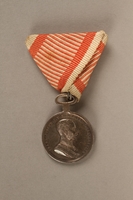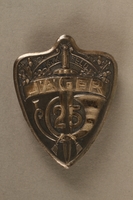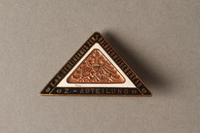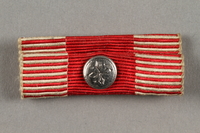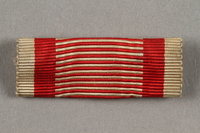Overview
- Description
- The collection documents the pre-war, wartime, and post-war lives of Alice and Jakob Kessler and their son Hans (later John) of Austria, including the management of the Hotel-Pension Rauhenstein-Helenschlössl in Baden, their emigration from Austria in 1938 to England and their immigration to the United States in 1940. The collection also includes materials regarding Alice’s parents Else and Max Neuhut, Alice’s second husband Berthold Feld, and Hans’s future wife Eva Bondy. The collection consists of biographical material, immigration papers, correspondence, restitution paperwork, writings and publications, and photographs.
Biographical material consists of personal documents related to the Alice and Jakob Kessler, their son Hans, Alice’s parents Else and Max Neuhut, Else’s brother Ivan Döry, Alice’s second husband Berthold Feld, and Hans’s future wife Eva Bondy. Included are birth, marriage, and death certificates; identification documents; financial papers; report cards; passports; employment papers; genealogy notes; and records related to Jakob’s service with the Austro-Hungarian Army during World War I. There are also documents regarding Hans’s baptism into the German Lutheran church (Evangelische Kirche) in 1934.
Immigration papers primarily consist of documents related to the Kessler’s emigration from Austria to England in 1938 and their immigration to the United States in 1940 and Else and Max Neuhut’s immigration to Havana, Cuba and the United States. The papers related to the Kessler’s immigration to England include Austrian emigration paperwork, correspondence regarding employment, ration cards, and medical cards. Papers related to the Kessler’s immigration to the United States include Affidavits of Support, immigrant identification cards, naturalization correspondence and naturalization certificates. Else and Max Neuhut’s immigration papers include identification documents, Affidavit in Lieu of Passports, and naturalization paperwork. Also included are Berthold Feld’s re-entry permit for the Dominican Republic and the Bondy family’s souvenir log for the SS Manhattan.
Correspondence chiefly consists of wartime letters received by the Kesslers from relatives and family including Else’s brother Ivan Döry and his son Hans Döry, Gaston Neuhut, and Max Neuhut. There are also post-war letters to Alice from her second husband Berthold Feld and various relatives regarding restitution and other matters.
The Hotel-Pension Rauhenstein-Helenschlössl materials include ledgers, a small amount of financial paperwork, a letter of recommendation for Alice Kessler, postcards, and a blueprint of the hotel layout.
Restitution records consist of large amounts of documents and correspondence regarding reparations for Alice and Hans; Alice’s uncle Paul Döry, who was murdered at Auschwitz; Berthold Feld; and the Kessler’s Austrian business the Hotel-Pension Rauhenstein-Helenschlössl. Much of the restitution paperwork for Paul Döry and Berthold Feld was handled by Alice.
Writings, publications, and ephemera include personal narratives, articles, poems, and recipe books. Eva Bondy’s “The Story of My Life” is an illustrated personal narrative written as a teenager after she immigrated to the United States. Else Neuhut’s Der Kanari Simba” is a typed manuscript of a children’s story she wrote. The October 1942 issue of El Informativo Mitteilungen features an article in German by Else entitled “Mein schwarzer Spitzenhut” chronicling her and Max’s flight from Vienna to Cuba. The United Yugoslav Relief Fund of America News Bulletin features a photograph of Eva Bondy in Yugoslav attire for a Yugoslav bazaar in 1946. Additionally, there are 10 handwritten recipe books in German.
Photographs consist of prints and albums primarily depicting the pre-war lives of the Kessler, Neuhut, and Bondy families. The Kessler family subjects include candid family scenes, portraits, Hans’s childhood, Jakob in uniform in the Austrian Army during World War I, various relatives, and the family’s hotel in Baden. The Neuhut photographs are primarily of Else and Max, along with other relatives. The Bondy family photographs include depictions of family vacations to resorts in Austria, Croatia, and the World’s Fair in New York; Eva’s childhood; portraits; and candid family scenes. There is also one photograph of Alice’s second husband Berthold Feld.
Biographical material consists of personal documents related to the Alice and Jakob Kessler, their son Hans, Alice’s parents Else and Max Neuhut, Else’s brother Ivan Döry, Alice’s second husband Berthold Feld, and Hans’s future wife Eva Bondy. Included are birth, marriage, and death certificates; identification documents; financial papers; report cards; passports; employment papers; genealogy notes; and records related to Jakob’s service with the Austro-Hungarian Army during World War I. There are also documents regarding Hans’s baptism in an Evangelical church in 1934.
Immigration papers primarily consist of documents related to the Kessler’s emigration from Austria to England in 1938 and their immigration to the United States in 1940 and Else and Max Neuhut’s immigration to Havana, Cuba and the United States. The papers related to the Kessler’s immigration to England include Austrian emigration paperwork, correspondence regarding employment, ration cards, and medical cards. Papers related to the Kessler’s immigration to the United States include Affidavits of Support, immigrant identification cards, naturalization correspondence and naturalization certificates. Else and Max Neuhut’s immigration papers include identification documents, Affidavit in Lieu of Passports, and naturalization paperwork. Also included are Berthold Feld’s re-entry permit for the Dominican Republic and the Bondy family’s souvenir log for the SS Manhattan.
Correspondence chiefly consists of wartime letters received by the Kesslers from relatives and family including Else’s brother Ivan Döry and his son Hans Döry, Gaston Neuhut, and Max Neuhut. There are also post-war letters to Alice from her second husband Berthold Feld and various relatives regarding restitution and other matters.
The Hotel-Pension Rauhenstein-Helenschlössl materials include ledgers, a small amount of financial paperwork, a letter of recommendation for Alice Kessler, postcards, and a blueprint of the hotel layout. - Date
-
inclusive:
circa 1869-2015
bulk: 1914-1998
- Credit Line
- United States Holocaust Memorial Museum Collection, Gift of John Otto Kessler
- Collection Creator
- Kessler family
- Biography
-
Jakob Kessler (later Jacques Kessler, nicknamed Suzi (by his wife Lizzy only), 1890-1945) was born on 8 May 1890 in Dunajów, Galicia (Dunayev, Ukraine) to David Hersch Kessler and Scheindel Kessler (née Bernzweig). He had five sisters and two brothers: Anna (Boltuch), Elsa (Winter), Fanny (Kleinberg), Sabine (Bien), Perl/Peppy (Kavaler), Leon, and Willy. Jakob served with the Austro-Hungarian Army during World War I and was shot in a prone position. The bullet entered his shoulder and exited through his leg. He refused amputation of his partially frozen leg and eventually recovered his ability to walk. After his recovery, Jakob became an enthusiastic hiker and mountain climber in the Alps.
Alice Blanca Kessler (née Neuhut, later Alice Feld, nicknamed Lizzy, 1903-1981) was born on 26 December 1903 in Vienna, Austria to Maximilian Neuhut (Max, b. 1872) and Else (née Döry, 1876-1943) Neuhut. Her grandparents, Emil Deutsch (later Emil Döry, d. 1896) and Ilke (Ilona or Eleonore, d. 1922) Blass, converted from Judaism to Catholicism in 1888. Else studied Buddhism and was a published author. Her family was also active in sports. Max was “Underwater swimming champion" of Europe and a top water polo player. Max and Alice were also long distance swimmers.
Jakob and Alice married in 1926, and she converted back to Judiasm in an Orthodox ceremony. Their son Hans Otto Kessler (later John, nicknamed Hansi) was born on 26 November 1928 in Vienna. The Kesslers were then Jewish, but not actively religious. In 1934 Hans, his mother Alice, and his grandmother Else were baptized in the Lutheran church (Evangelische Kirche).
Alice was a professional leather worker, artist, and designer. She also studied cooking at the Grand Hotel in Vienna and reached professional status as a gourmet cook. Alice and her mother traveled to England to a leatherware fair where she sold her leather output, with original designs. Concurrently, she learned conversational English. She enjoyed and read only English novels (mostly detective novels) throughout her life.
In 1933 the Kesslers moved to Baden, approximately thirty-five miles from Vienna. Max retired from his position as the sales director for a light bulb company (which later became Tungsram and eventually Sylvania) and purchased the Hotel-Pension Rauhenstein-Helenenschlössl hotel (also known as Haus Lizzy). Alice worked as a chef at the hotel, and Jakob managed the finances.
In November 1938 Jakob was arrested and detained in Vienna, and preparations were being made to deport him to a concentration camp. He was not harmed, he believed, because he only spoke in a style emphasizing his military background. While in detention, he witnessed sadistic horrors perpetrated by the Austrian Nazi jailers. Meanwhile Alice went to a library, using her facility with the English language to read the London Times. She found an advertisement for a job for a “married couple”, cook and butler. She long-distance telephoned the people who placed the ad and got the job. She then went to the British consulate and managed to obtain visas for herself, Jakob, and Hans. She used the exit visa to get Jakob out of jail, and within days they escaped by train from Austria to England via Germany and Belgium.
In England, Alice worked as a chef and Jakob worked as a butler in Fernhurst, Sussex. Hans attended Midhurst Grammar School, a boarding school nearby. The family immigrated to the United States in 1940. They briefly lived in New York, but decided to settle in Jacksonville, Florida. Hans attended boarding school in Connecticut for one year. Boarding school in Connecticut was paid for by his mother’s Uncle Gaston Neuhut, who had emigrated to the U.S. from Austria before the 1930s. Hans joined his parents after they were able to establish themselves financially in Florida. Alice and Jakob opened a bakery by 1943. The bakery failed shortly thereafter and Alice started a catering business, mostly for Jewish family parties. Jakob, now going by Jacques, worked as a bookkeeper for $20/week for a Jewish business.
Alice’s parents Else and Max lost control of their hotel in Baden and immigrated to Cuba in 1941. They came to the United States in 1943 and settled in Jacksonville with the Kesslers. Max later moved to New York after Else died in 1943. He committed suicide around 1945 or 1946.
Else had twin brothers Hans (Paul) and Ivan Döry. Hans had been a banker for the Austrian Central bank, was president of the Vienna Tierschutzverein, the Austrian animal humane society. He and his wife fled Austria to France after the German annexation in March 1938, but were later deported back to Austria by the Vichy government. Hans was then deported to Auschwitz where he perished. Ivan survived the Holocaust in Ecuador. Before the war, he was an electrical engineer who worked on the electrification of the Austrian railway system. After his move to Ecuador, one of Ivan’s projects was an attempt to disprove Einstein’s theory of relativity.
After graduating Robert E. Lee high school in Jacksonville, FL, Hans, now John Kessler, attended Columbia University on a full scholarship. Jakob died in 1945, and the same year Alice moved to New York to be with her son. She married Berthold Feld (b. 1898) in 1948 and became a commercial artist. Hans graduated from Columbia University College in 1949 and received a PhD in Physics from Columbia in 1953. He married Eva Bondy in 1950. He worked as a physicist at RCA Laboratories (Princeton) and at the Princeton University high temperature plasma laboratory. In 1966 he became Professor of Physics at the University of Arizona.
Eva Magdalena Bondy (later Eva Kessler, 1926-2014) was born in Vienna to Alfred (1897-1972) and Emilie (née Rothziegel, b. 1897) Bondy. She had one brother, Michael. Her family moved to Zagreb (Croatia) when she was a child. Alfred was a manager at a Zagreb textile factory. Her family immigrated to the United States via Italy aboard the SS Manhattan in 1940. Alfred became the importer to the USA of BMW motorcycles through his company, Butler and Smith, based in New York City.
Physical Details
- Extent
-
5 boxes
5 oversize boxes
2 book enclosures
7 oversize folders
- System of Arrangement
- This collection is arranged as seven series.
Series 1. Biographical material, 1872-2015
Series 2. Immigration, 1938-1953
Series 3. Correspondence, 1914-1965
Series 4. Hotel-Pension Rauhenstein-Helenschlössl, 1933-1969
Series 5. Restitution, 1939-1998
Series 6. Writings, publications, and ephemera, 1939-1943 and undated
Series 7. Photographs, circa 1869-1950 and undated
Rights & Restrictions
- Conditions on Access
- There are no known restrictions on access to this material.
- Conditions on Use
- Material(s) in this collection may be protected by copyright and/or related rights. You do not require further permission from the Museum to use this material. The user is solely responsible for making a determination as to if and how the material may be used.
- Copyright Holder
- Professor John Otto Kessler
Keywords & Subjects
Administrative Notes
- Holder of Originals
-
United States Holocaust Memorial Museum
- Legal Status
- Permanent Collection
- Provenance
- The collection was donated to the United States Holocaust Memorial Museum by John Otto Kessler in 2017.
- Funding Note
- The acquisition of this collection was made possible by Lori and Alan Zekelman.
- Record last modified:
- 2023-02-24 14:31:53
- This page:
- https://collections.ushmm.org/search/catalog/irn564724
Additional Resources
Download & Licensing
- In Copyright - Use Permitted
- Terms of Use
- This record is not digitized and cannot be downloaded online.
In-Person Research
- Not Available for Research: Out for Digitization
- Plan a Research Visit
-
Request in Shapell Center Reading Room
Bowie, MD
Contact Us
Also in Kessler family collection
Collection of documents, photographs, artifacts and film illustrating the experiences of Alice and Jakob Kessler and their son, Hans Otto, who was born in Vienna, Austria and raised in Baden, Austria. Their experiences fleeing to the United Kingdom in 1939 and then immigrating to the United States in the early 1940s, as well as the experiences of the extended family is also documented in the collection.
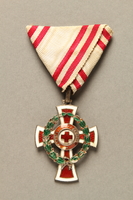
Red Cross medal
Object
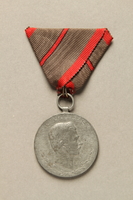
Austro-Hungarian wound medal
Object
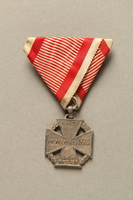
Karl Troop Cross medal
Object
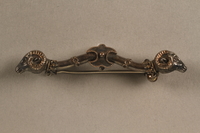
Ram's Head Pin
Object
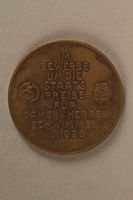
Bronze medal for swimming
Object
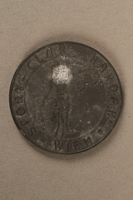
Sport-club swimming medal
Object
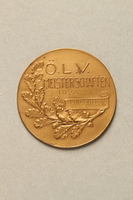
Handball championship medal
Object
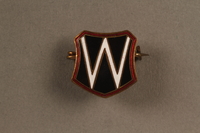
"W" Pin
Object
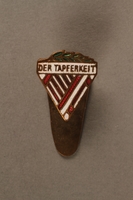
Bravery clip
Object
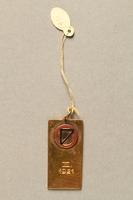
1921 Swimming medal
Object
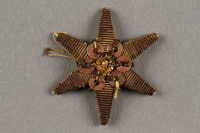
Star Shaped Applique
Object
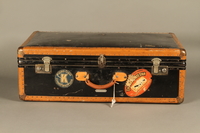
Suitcase
Object
Suitcase with detachable interior tray. Part of a ollection of documents, photographs, artifacts and film illustrating the experiences of Alice and Jakob Kessler and their son, Hans Otto, who was born in Vienna, Austria and raised in Baden, Austria. Their experiences fleeing to the United Kingdom in 1939 and then immigrating to the United States in the early 1940s, as well as the experiences of the extended family are also documented in the collection.
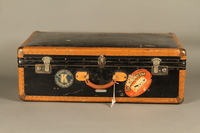
Medal
Object
Part of a collection of documents, photographs, artifacts and film illustrating the experiences of Alice and Jakob Kessler and their son, Hans Otto, who was born in Vienna, Austria and raised in Baden, Austria. Their experiences fleeing to the United Kingdom in 1939 and then immigrating to the United States in the early 1940s, as well as the experiences of the extended family are also documented in the collection.
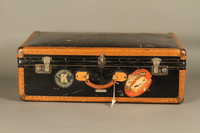
Medal
Object
Part of a collection of documents, photographs, artifacts and film illustrating the experiences of Alice and Jakob Kessler and their son, Hans Otto, who was born in Vienna, Austria and raised in Baden, Austria. Their experiences fleeing to the United Kingdom in 1939 and then immigrating to the United States in the early 1940s, as well as the experiences of the extended family are also documented in the collection.
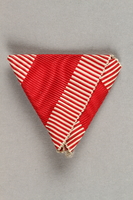
medal ribbon
Object
Part of a collection of documents, photographs, artifacts and film illustrating the experiences of Alice and Jakob Kessler and their son, Hans Otto, who was born in Vienna, Austria and raised in Baden, Austria. Their experiences fleeing to the United Kingdom in 1939 and then immigrating to the United States in the early 1940s, as well as the experiences of the extended family are also documented in the collection.
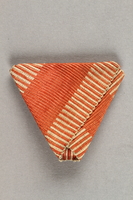
medal ribbon
Object
Part of a collection of documents, photographs, artifacts and film illustrating the experiences of Alice and Jakob Kessler and their son, Hans Otto, who was born in Vienna, Austria and raised in Baden, Austria. Their experiences fleeing to the United Kingdom in 1939 and then immigrating to the United States in the early 1940s, as well as the experiences of the extended family are also documented in the collection.
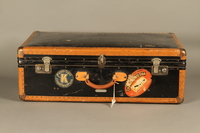
Metal paper holder
Object
Paper holder contains folded paper inside with text. Part of a collection of documents, photographs, artifacts and film illustrating the experiences of Alice and Jakob Kessler and their son, Hans Otto, who was born in Vienna, Austria and raised in Baden, Austria. Their experiences fleeing to the United Kingdom in 1939 and then immigrating to the United States in the early 1940s, as well as the experiences of the extended family are also documented in the collection.
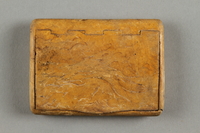
Wood Cigarette Holder
Object
Wood cigarette holder contains two cigarettes and pack of papers. Part of a collection of documents, photographs, artifacts and film illustrating the experiences of Alice and Jakob Kessler and their son, Hans Otto, who was born in Vienna, Austria and raised in Baden, Austria. Their experiences fleeing to the United Kingdom in 1939 and then immigrating to the United States in the early 1940s, as well as the experiences of the extended family are also documented in the collection.
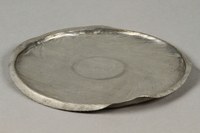
KitchenAid Model G stand mixer with attachments
Object
Kitchenaid Mixmaster with parts and attachments. Part of a collection of documents, photographs, artifacts and film illustrating the experiences of Alice and Jakob Kessler and their son, Hans Otto, who was born in Vienna, Austria and raised in Baden, Austria. Their experiences fleeing to the United Kingdom in 1939 and then immigrating to the United States in the early 1940s, as well as the experiences of the extended family are also documented in the collection.
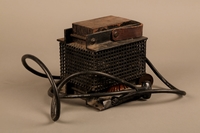
Power converter
Object
Power converter. Part of a collection of documents, photographs, artifacts and film illustrating the experiences of Alice and Jakob Kessler and their son, Hans Otto, who was born in Vienna, Austria and raised in Baden, Austria. Their experiences fleeing to the United Kingdom in 1939 and then immigrating to the United States in the early 1940s, as well as the experiences of the extended family are also documented in the collection.
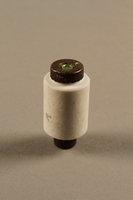
Fuses
Object
Fuses. Part of a collection of documents, photographs, artifacts and film illustrating the experiences of Alice and Jakob Kessler and their son, Hans Otto, who was born in Vienna, Austria and raised in Baden, Austria. Their experiences fleeing to the United Kingdom in 1939 and then immigrating to the United States in the early 1940s, as well as the experiences of the extended family are also documented in the collection.
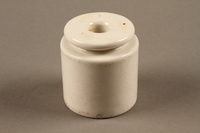
Ceramic insulators
Object
Ceramic insulators. Part of a collection of documents, photographs, artifacts and film illustrating the experiences of Alice and Jakob Kessler and their son, Hans Otto, who was born in Vienna, Austria and raised in Baden, Austria. Their experiences fleeing to the United Kingdom in 1939 and then immigrating to the United States in the early 1940s, as well as the experiences of the extended family are also documented in the collection.
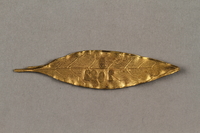
Leaf-shaped metal pieces
Object
Leaf-shaped metal pieces stamped with the years 1921 and 1922 and the number three. Part of a collection of documents, photographs, artifacts and film illustrating the experiences of Alice and Jakob Kessler and their son, Hans Otto, who was born in Vienna, Austria and raised in Baden, Austria. Their experiences fleeing to the United Kingdom in 1939 and then immigrating to the United States in the early 1940s, as well as the experiences of the extended family are also documented in the collection.
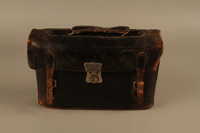
Briefcase
Object
Leather briefcase. Part of a collection of documents, photographs, artifacts and film illustrating the experiences of Alice and Jakob Kessler and their son, Hans Otto, who was born in Vienna, Austria and raised in Baden, Austria. Their experiences fleeing to the United Kingdom in 1939 and then immigrating to the United States in the early 1940s, as well as the experiences of the extended family are also documented in the collection.
Typewriter and case
Object
Regent typewriter with case. Part of a collection of documents, photographs, artifacts and film illustrating the experiences of Alice and Jakob Kessler and their son, Hans Otto, who was born in Vienna, Austria and raised in Baden, Austria. Their experiences fleeing to the United Kingdom in 1939 and then immigrating to the United States in the early 1940s, as well as the experiences of the extended family are also documented in the collection.
Wooden spoon
Object
Wooden spoon. Part of a collection of documents, photographs, artifacts and film illustrating the experiences of Alice and Jakob Kessler and their son, Hans Otto, who was born in Vienna, Austria and raised in Baden, Austria. Their experiences fleeing to the United Kingdom in 1939 and then immigrating to the United States in the early 1940s, as well as the experiences of the extended family are also documented in the collection.
Wooden spoon
Object
Wooden spoon. Part of a collection of documents, photographs, artifacts and film illustrating the experiences of Alice and Jakob Kessler and their son, Hans Otto, who was born in Vienna, Austria and raised in Baden, Austria. Their experiences fleeing to the United Kingdom in 1939 and then immigrating to the United States in the early 1940s, as well as the experiences of the extended family are also documented in the collection.
Wooden spoon
Object
Wooden spoon. Part of a collection of documents, photographs, artifacts and film illustrating the experiences of Alice and Jakob Kessler and their son, Hans Otto, who was born in Vienna, Austria and raised in Baden, Austria. Their experiences fleeing to the United Kingdom in 1939 and then immigrating to the United States in the early 1940s, as well as the experiences of the extended family are also documented in the collection.
Wooden stirrer
Object
Wooden stirrer. Part of a collection of documents, photographs, artifacts and film illustrating the experiences of Alice and Jakob Kessler and their son, Hans Otto, who was born in Vienna, Austria and raised in Baden, Austria. Their experiences fleeing to the United Kingdom in 1939 and then immigrating to the United States in the early 1940s, as well as the experiences of the extended family are also documented in the collection.

